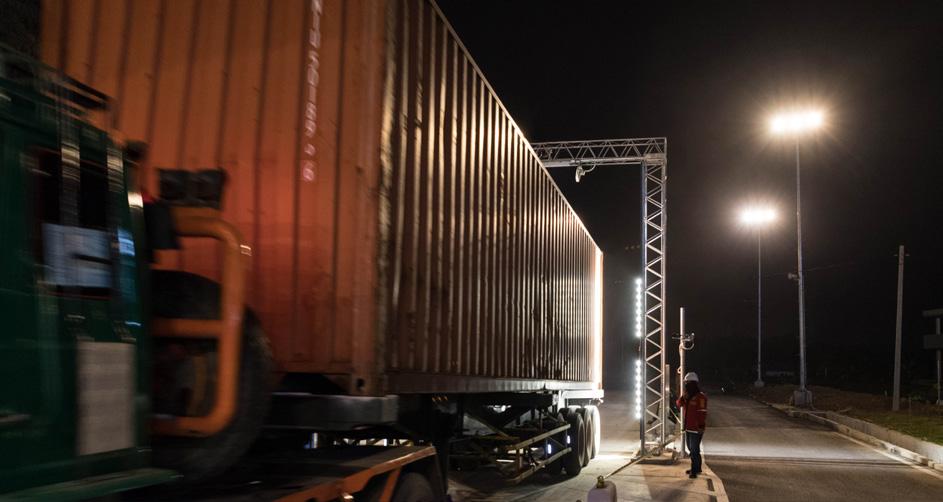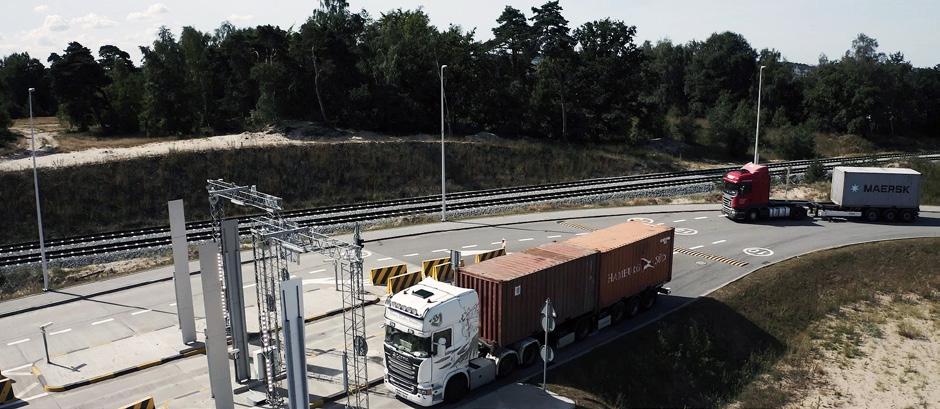
6 minute read
First of its kind
by John Lund, Sales and Marketing Director (Global), Visy Oy Aspects of science fiction films from the 1980s and 90s are becoming a reality in the modern container terminal. Some 20 years ago, vision technology in terminal operations was limited to optical character recognition (OCR) for container code recognition (CCR) and license plate recognition (LPR; also referred to as automatic number plate recognition, ANPR, depending on your geography). The game-changer in vision technology occurred in 2013 with the advent of dynamic neural networks (DNN). Long story short, using a DNN provides a faster, more efficient, and more accurate way to extract data from images using deep learning techniques. The benefit for the industry is that virtually everything that you photograph can be automatically digitised and therefore used as a basis for process automation. The latest application for container terminals, and those interested in a container’s condition, comes in the form of Visy’s Automatic Damage Detection System (ADDS), the first system of its kind.
It is safe to say that the issues surrounding damaged containers cost the industry billions of dollars per year. Broken boxes lead to spoiled with OCR for trucks, train GOS for rail operations, and crane OCR for quayside movements. These deployments all utilise vision technology to collect event data (box captures images of the roof and uses those images for CCR, twin-20’ detection, and ADDS. The operator receives confirmation of the box IDs even before offloadcargo, and containers with severe structural damage present safety problems. Indeed, a container full of waterlogged iPhones, or one with warped corner posts that causes a stack to collapse, will evoke a ripple effect of insurance claims, angry customers, delays, and safety concerns. As a result, many container terminals have created processes to manage damaged cargo. However, until recently, those processes have been manual and therefore labour-intensive, slow, error-prone, and unpredictable despite management’s best efforts. Today, damage inspection is automated through ADDS. This process automation improves the terminal’s key performance indicators (KPIs), including truck turnaround times, lifts per hour, and profitability.
Advertisement
Container terminals use OCR camera systems to identify assets entering or exiting the facility via road, rail, or quay to improve KPIs. The common industry terms for these solutions are gate operating system (GOS) ID, seal presence, door direction, hazardous goods labels, etc.) and share it with thirdparty systems such as the terminal operating system (TOS). The same camera systems can now be upgraded to include the ADDS feature through a simple software add-on. For example, as a truck drives through an OCR pre-gate portal and images are taken to identify the box number, the same camera system now tells the operator if the box is damaged, shows where the impairment is and specifies the damage type. Afterwards, it is up to each operator how they want to use this new, digitised data.
Quayside operations
As boxes enter the terminal via shipto-shore gantries, images are taken of all visible sides by the crane OCR system. Cameras are typically located in the spreader and on the crane’s frame. As the spreader grabs the box(es), Visy’s TopView application (i.e., spreader OCR system) ing, thus preventing wrong moves. As the containers move into the exchange area, the frame cameras capture images of each box’s long and short sides. These images are also used for automatic data processing, not least the box ID, ISO code, door direction, hazardous goods labels, tare weight, seal presence, and damage detection. Before the cargo touches the ground, the operator knows everything about it, including its condition. The information is digitised and shared with the TOS, meaning that exceptions, such as the lack of seal or extreme damage, are promptly managed. Perhaps the operator changes a work order so that a box goes to the maintenance & repair (M&R) centre and then updates the shipping line. With digitised data, previously inconceivable levels of automation become the standard. The same data are used during loading operations. When a box is picked from the quay, all relevant information is captured, including its state. In this case, the
Photos: Visy Oy



terminal automatically collects and shares the standard OCR features, such as the box ID, but also confirms that the box is fit for sea travel. An equipment interchange receipt (EIR) can be automatically created and shared with the shipping line using the digitised data codes. Additionally, the terminal verifies that the box was in the same condition when it entered the terminal, refuting potential damage claims.
Truck gates
Before trucks and cargo arrive at the main gate, they typically drive through an OCR pre-gate portal. Depending on the operation, the portal is equipped with lights and cameras to capture high-resolution images for the OCR processes. The data extracted from the images will be similar to that utilised in quayside operations, save for apparent differences like truck license plates instead of terminal tractor ID, etc. Again, using a single set of images from the OCR portal, ADDS will find damage on the cargo, digitise the result, and create an exception handling event if required. Because the damage condition is digitalised, the work order can be automatically changed, and the container can be rerouted to the M&R centre if warranted by its state.
Much like the in-gate process, the outgate process can be automated with ADDS. As the truck drives through the out-gate OCR portal, hi-res images are taken before reaching the main gate area, and all relevant data are acquired. The cargo is matched with the truck and work order, and the damage condition is determined. If the cargo is unfit for road travel, or some other discrepancy exists, the truck will be prohibited from leaving the terminal as an exception handling event. If there are no discrepancies, the truck will go, and the terminal has evidence that the assets were in acceptable condition when exiting the facility.
Rail operations
Like the truck pre-gate portals, rail tracks can be equipped with train GOS OCR portals to collect and share data in a variety of train operations. The train OCR portals work with double-stacked, dual-track, and bi-directional operations as the site requires. As the train travels through the portal, cameras capture hi-res images of the wagons and cargo to extract and share relevant data such as the box and wagon IDs and the composition.
The data are shared with the TOS and compared to the expected composition. Exception handling events are created in the system for box/wagon discrepancies and damaged cargo alike. If a box is damaged upon arrival, the information can be automatically shared with a third-party system before the terminal even offloads it. Similarly, as the train is departing, the OCR portal will verify that the boxes are in acceptable condition when they leave the facility.
Only the beginning of a new era
Visy ADDS automatically digitises the condition of shipping containers. This tool presents a massive opportunity for operators and the industry alike. The ability to automatically know the condition of a box as it arrives at a terminal would have qualified as sci-fi only two decades ago. Today, operators can utilise deep learning technology to automate processes, provide better customer services, and make prudent business decisions.
Sharing damaged cargo data with thirdparty systems like the TOS, creating a website for customers, or automatically generating and sending EIR reports are only the beginning of this new era in terminal automation. It will be amazing to see where vision technology takes the industry after another 20 years of development.
Visy provides process automation ecosystems to manage the flow of traffic, cargo and personnel in transportation hubs and logistics centers. Every asset that goes in or out of a facility, whether by road, rail or quay, can be managed by Visy technology. Using vision technology and other data collection tools, Visy ecosystems manage more than 5,000,000 automation tasks per day in over 25 countries. Visit www.visy.fi to learn more.









